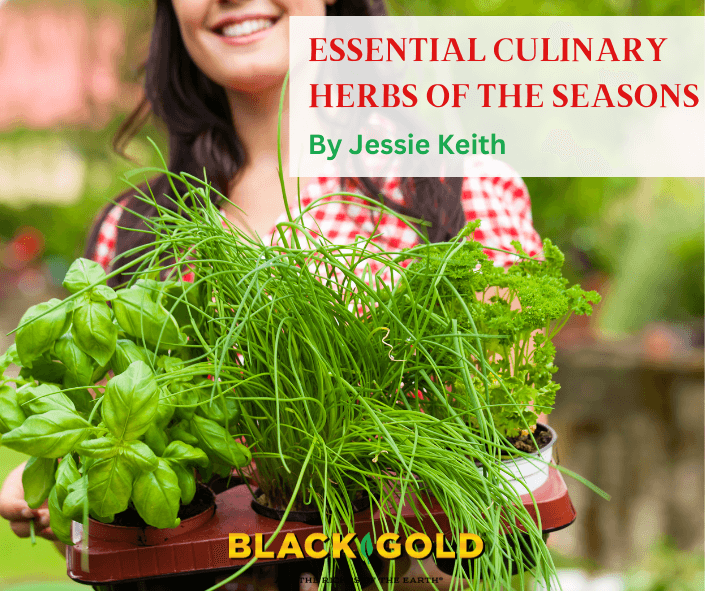
Stylish and serviceable herb gardens are a delight through the growing season when they appeal to the eye and senses and provide fresh herbs. In winter, stores of dried and frozen herbs make cooking a pleasure. If you don’t already have a culinary herb garden, you are missing out. And, there’s no reason not to grow one. Essential culinary herbs are the easiest plants in a food gardener’s repertoire.
Every culture relies on essential herbs to flavor its foods. In past blogs, we have written about French herb gardens, Indian herb gardens, herbal tea gardens, herb containers, lemon-scented herbs, and apothecary gardens, but oddly enough, we have never written about growing herbs essential to Western cuisine. These are the common (and pricy) herbs that homeowners buy at the grocery store (even though they grow like weeds). Herbs are yawn and water garden plants unless you want to make a show and create a formal herbary or knot garden.
Essential Herbs of Spring

The first chives of spring are so bright and welcome when added to fresh vegetables and salads, as are the tender leaves of parsley when they begin to unfurl and are at their sweetest. Fine cilantro and dill–both cool-season annuals–are two other spring herbs no garden should be without. In late spring, count on chamomile to produce its sweet daisies that are harvested and dried to make delicious, soothing tea to enjoy year-round. These are the spring herb essentials.
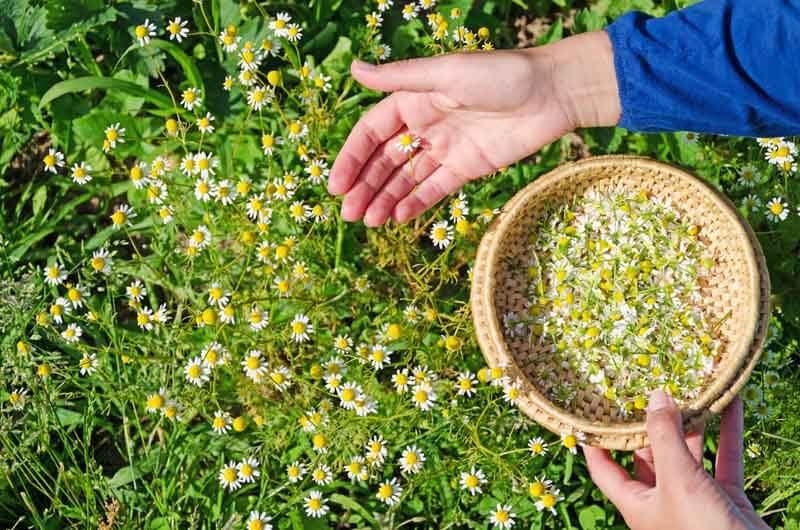
Chives (Allium schoenoprasum, USDA Hardiness Zones 4-8): Chives put forth tidy clusters of oniony, grassy foliage in spring. Pompons of edible mauve flowers bloom in mid-spring, rising above the upright foliage. Harvest them fresh, when they are most flavorful. In summer, chives wane in the heat but will often perk back up in fall.
Chamomile (Matricaria retutica, Zones 2-8) is a winter annual or short-lived perennial to sow in fall. It will overwinter as a ferny green rosette and then bloom in full glory with a flurry of small white daisies in spring. Harvest the flowers for drying when they just begin to open. Allow some plants to set seed to encourage new fall seedlings.
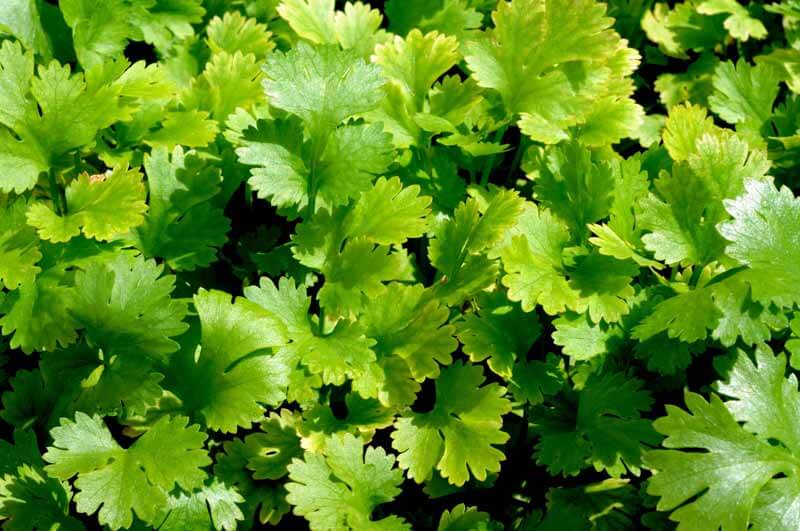
Cilantro (Coriandrum sativum) is a leafy annual that likes it cool and starts producing stems of white flowers and seeds as the weather heats up. But, that’s a good thing because its seedheads, which dry by summer, are crushed to make the spice coriander. Harvest the leaves while you can for guacamole, salads, and salsas. Also, consider cilantro a fall herb to seed in no later than early September.
Dill (Anethum graveolens) is a true spring annual herb that you only need to plant once. Harvest the ferny green leaves to flavor salads, spreads, and pickles, and
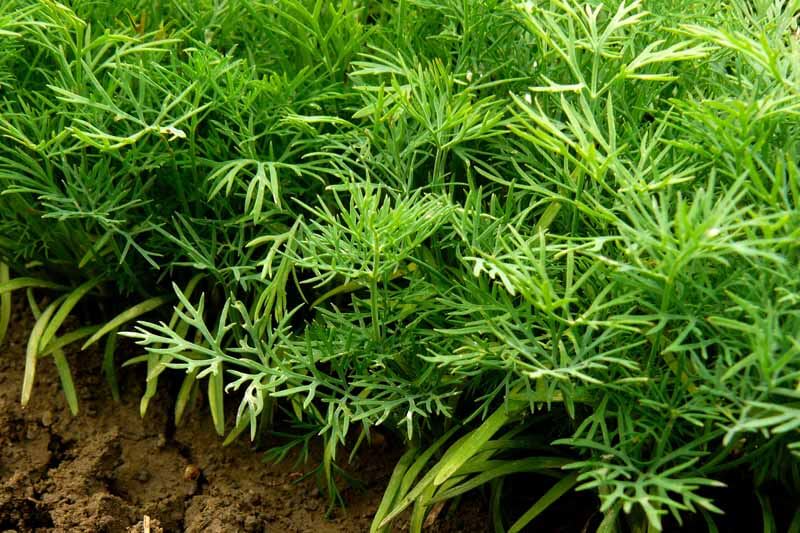
let the yellow-green umbel flowerheads dry for flavorful dill seed. Let some seeds fall to the ground and sprout for a second dill harvest in the fall.
Parsley (Petroselinum crispum) comes in curly and flat-leaved forms and lends fresh flavor to sauces, salads, and meats. Lush clumps of parsley leaves flourish in the cool spring weather and give way to flowering in the heat of summer, after which the plants die. If you replant parsley in the fall, it will often survive through winter.
Essential Herbs of Summer
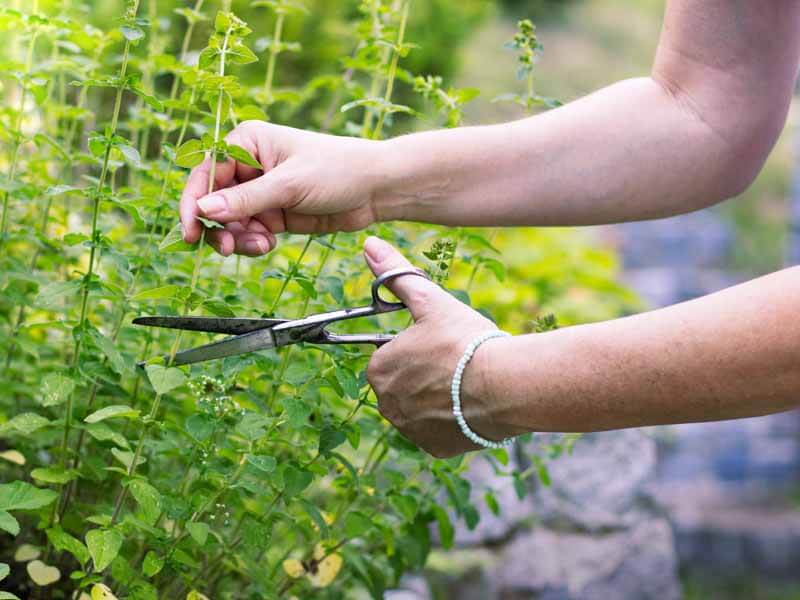
Sweet basil tastes like summer–whether used to flavor sauce, pesto or added to a citrusy summer drink. Mints of all kinds grow rampantly and need containment, but every gardener should have at least one pot of good mint. Thymes, especially lemon thyme, is a summer staple at my home that lends itself well to chicken, fish, salads, and vegetables. Oregano and piney rosemary are necessities for grilled meats and vegetables. These are the summer herb essentials.
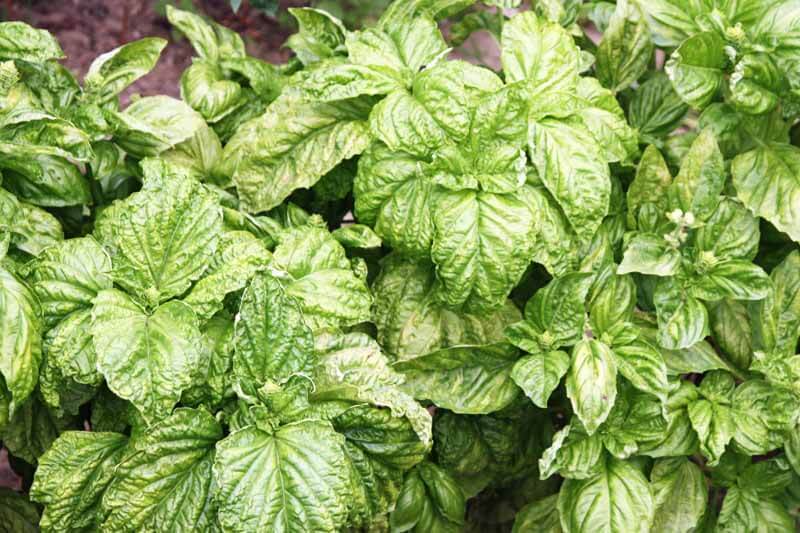
Basil (Ocimum basilicum) is a warm-season herb that’s grown as an annual. The key to keeping it sweet and flavorful is to clip off the flower heads as they appear. Grow it in the garden or in containers. (See the video below to learn how to care for container-grown basil.), and clip the leaves all summer to keep plants tidy and flavorful. (Click here to learn how to grow basil indoors in winter.)
Mint (Mentha spp.) leaves flavor summer mojitos, tabouli, and fresh mint tea. The plant is so easy to grow you can plunk a stem in a glass of water, and it will root in a week. Its aggressive nature is a mint’s only downfall. One seemingly harmless plant can take over a garden in no time, so plant it in a big pot filled with Black Gold Natural & Organic Potting Soil to keep its roots from roaming. When it starts to
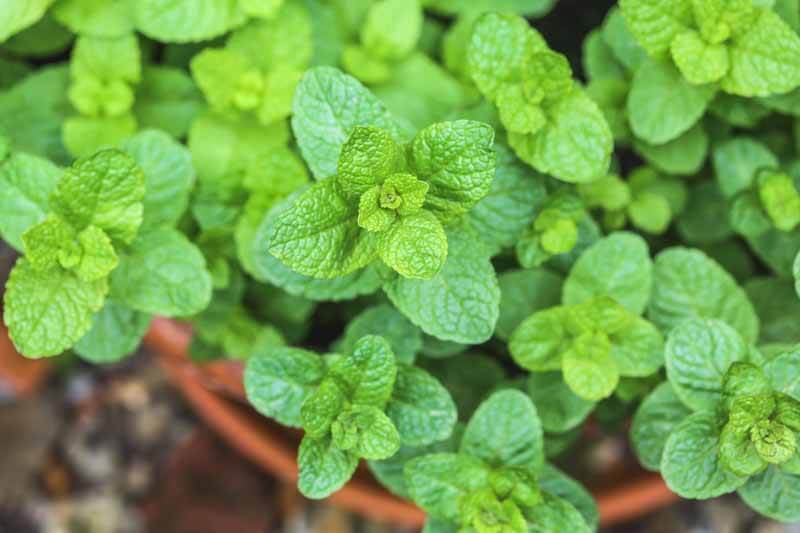
outgrow the pot, divide it, and give the spare to a friend (with fair warning).
Oregano (Origanum vulgare, Zones 4-10) has rooting stems that tend to spread, so be sure to give it space to grow. You can also contain oregano in a pot. Clusters of edible purple flowers bloom in midsummer, which attracts bees. Use the leaves to flavor meats, vegetables, and sauces in summer. In the fall, dry or freeze the leaves for winter cooking.

Rosemary (Rosmarinus officinalis, Zones 8-10) is a drought-tolerant, shrubby, evergreen herb with resinous needle-like leaves that taste great on meats and in sauces. Bees are attracted to its violet-blue flowers that bloom in late spring. The cold-tolerant variety ‘Arp’ (Zones 6-10) is a hardier option for northern gardeners. Dry the leaves for winter use.
Thyme (Thymus spp., Zones 5-9) has small, aromatic leaves that are evergreen. In late spring, the low, spreading, shrubby herb bears small clusters of flowers for bees that may be pink, purplish, or white. Plant it along a patio edge where it can spill across the pavement or in a pot. Harvest the leafy stems any time of year to add to many dishes or dry the leaves for herbal mixes.
Essential Herbs of Fall and Winter
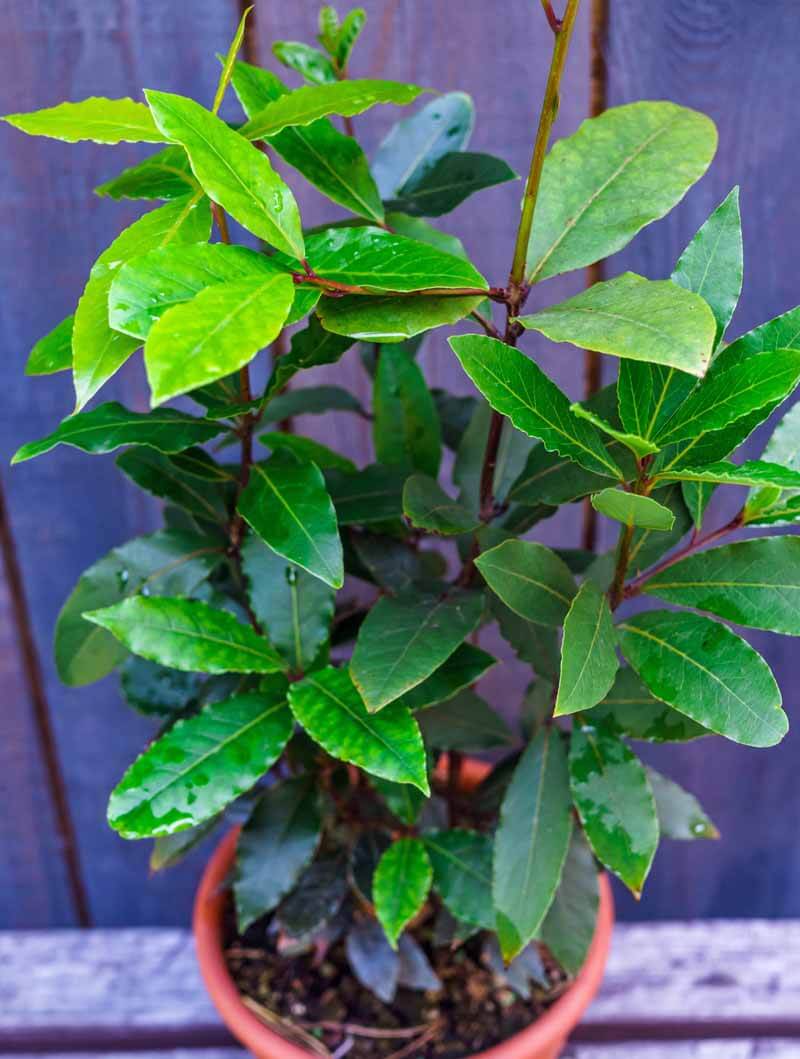
Sage tastes of turkey stuffing and pairs well with pumpkin. And bean soups never taste quite as good without the complement of winter savory. A big pot of bay leaf should be a winter houseplant for every gardener who cooks. Just be sure to take the pot outdoors in summer to let the Mediterranean tree to enjoy the sunshine. Spicy ginger is another indoor/outdoor tropical herb that will grow well in a sunny window. These are the essential herbs of winter.

Bayleaf (Laurus nobilis, Zones 8-10) will grow as a 20-30 foot evergreen tree where it is hardy, but if kept pruned in a pot, it will stay compact. Harvest the leaves for soups, sauces, and meats, but keep in mind that new leaves will not be produced until spring, so be sure not to strip the plant of all greenery and kill it. Pot-grown specimens thrive in OMRI Listed®Black Gold Natural & Organic Potting Mix. (Click here to learn more about growing bay leaf.)
Ginger (Zingiber officinale) grows very well as a potted house plant in a brightly lit spot with good humidity. Its roots can be harvested as the plants grow and used to make sweet and savory dishes. As with bay leaf, bring your potted ginger outdoors in summer to allow it to grow to its fullest. (Click here to learn more about growing ginger.)

Sage (Salvia officinalis, Zones 4-8) has felted, gray-green, evergreen leaves with a pungent flavor. The hardy shrubby perennial bears pretty lavender-blue flowers in summer, which are also edible and attract bees. It is best to harvest and dry leaves in the fall for winter cooking, but if you run out, you can always pick off a winter leaf or two without harming the plant.
Winter Savory (Satureja montana, Zones 6-8) The low, semi-evergreen winter savory looks attractive throughout much of the season. Its peppery leaves add flavor to green beans, soups, and stews. In summer, it has clusters of white or pinkish flowers that attract bees. Plant it along the edge of an herbal border.
Growing Herbs

To make it easy, all of these essential culinary herbs grow best in full sun and fertile soil with good drainage. Most are not too demanding when it comes to fertilizer, but a little all-purpose plant food at the beginning of the season never hurts. Spring is the best time to plant them, aside from tender indoor/outdoor herbs. Before planting, amend your garden soil with good compost, such as OMRI Listed® Black Gold Garden Compost Blend, to encourage good rooting and drainage.
When planning an herb garden, it’s smart to keep your annual and perennial herbs apart. Perennial herb borders are attractive and have permanence. They look right at home in raised beds or even pretty herbal rockeries. Just remember to reserve mints for big patio pots. Annual herbs are nice to plant among complementary vegetables. Dill is right at home planted alongside cucumbers, and almost everybody plants their sweet basil around garden tomatoes. Chamomile looks pretty when planted in a row beside spring greens or cabbages. Then keep your herbs harvested and well-tended to make the most of them all year round. (Click here to learn how to harvest and store herbs.)

